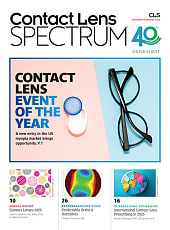ask the labs
Some Like it HOT
Karlen McLean, ABOC, NCLC
Recently an EB reader inquired: Which is better to use to adjust frames—a bead pan, salt pan, or a hot air blower? And, which is a better medium: salt or beads?
Here, Hilco's Paula Fazio, professional product manager, thoroughly answers this question.
■ SALT. Salt's advantage is that it's inexpensive. However, it does not heat consistently throughout the pan, which can create hot spots that can easily damage frames.
■ BEADS. Beads come in two different sizes. The smaller ones are as fine as salt; the larger, 2mm to 3mm in circumference. The large beads are easier to work with than salt or small beads because they won't go into small crevices in the frame or jam spring hinges. Some ECPs even add talcum powder to the mix to keep the beads from sticking. Both forms need to be frequently replaced.
Whether you use salt or beads, always start by stirring. Next, push the medium into a mound, usually at the center of the pan. Place the section of the frame to be heated just beneath the surface, and keep slowly moving the frame to prevent making pock marks in it. Heated frames should never get rubbery or start to lose shape.
■ HOT AIR. Hot air warmers are easier on an electric bill, definitely less messy, and you don't need to worry about marring frames with salt or beads. Look for a warmer with multiple settings.
FRAME MATERIALS
The thinness of the frame material is the single most important factor in determining proper heat settings for warming. The thinner the material, the faster it will heat up.
Use the lowest amount of heat needed to accomplish the task. Excess heat is an enemy of all frame materials. When a frame heats up, it will quickly soften. The frame is ready when it's pliable. Don't wait until it actually softens; if you do, it quickly becomes unmanageable.
Know your frame materials. Ask the manufacturer if you're unsure.
■ Cellulose acetate or zylonite is the most popular frame material. Cellulose acetate frames can be overheated easily, especially the darker colors. A hot air warmer at a moderate heat setting is recommended for these frames.
■ Cellulose propionate frames are highly heat sensitive and can stretch out of form easily when overheated.
■ Optyl frames can warp if they're overheated, and an under-heated optyl frame can snap during adjustment. Only heat the area of the frame that requires adjustment; hold the adjusted frame until the frame cools.
■ Polymide should be glazed cold. You should never use heat to insert lenses because it will shrink the polymide eyewire.
■ Nylon and carbon frames typically require high heat for adjustment, as they're very heat resistant. EB
| AR LENSES |
|---|
| When adjusting plastic frames with AR lenses, it's recommended to start with the lowest heat possible and only increase the temperature as needed. Also, heat concentrators are helpful for protecting lens coatings. Today's coatings are pretty tough, but that doesn't mean extreme heating and cooling won't damage them; cracking and crazing can still occur.1 |
If you have a question you'd like to have answered in Ask the Labs, send it to Susan P. Tarrant. Email: Susan.Tarrant@WoltersKluwer.com. An archive of past Ask the Labs columns can be found on the Eyecare Business website at eyecarebusiness.com.



